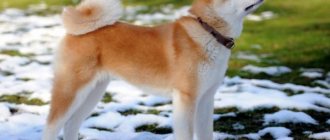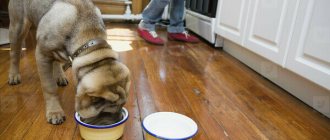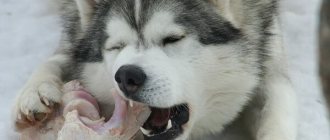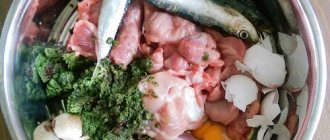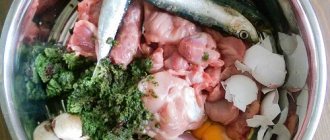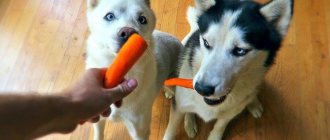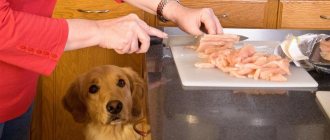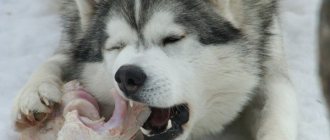Samoyeds are now used not only for riding, but also as a companion and as a family dog.
This animal copes well with all roles.
The Samoyed Laika is an intelligent and obedient dog with an attractive appearance.
She gets along easily with children and other animals, and she is a pleasure to train because she learns everything on the fly.
But we must not forget about the true purpose of the Samoyed and fill his life with activity and physical activity.
Description of the breed
Description of the Samoyed Laika breed starts with the animal's fur. Main characteristics of the breed:
The thick coat reliably protects the dog from bad weather. Considering that the tundra became the birthplace of the breed, Samoyeds are not afraid of even severe frosts. If the wool shows the correct structure, a special shine is characteristic. Has self-cleaning ability.
Samoyed huskies are famous for their “talkativeness” and smile. The latter effect occurs due to the peculiar arrangement of the eyes and raised corners of the mouth. Unfortunately, the Samoyed Laika breed has a drawback: the animals simply cannot stand being alone. If you decide to get a dog of this breed, but are unable to ensure that the pet is not left alone, you will have to get the dog a partner. You don't have to choose a Samoyed; any breed will do.
Samoyeds are so resilient and strong that they are able to pull loads many times their own weight. The Samoyed Laika breed is not used as a guard dog - there are no suitable skills. Animals of the breed are friendly, have a cheerful disposition, and love children. Dogs are ideal for hunting. Not shy or aggressive.
Samoyed huskies have not been modified by breeders. The appearance and character are the merits of the dogs. The breed owes its name to the Samoyeds, a northern Nenets tribe. Nomads extremely valued huskies for their dedication and ability to perform high physical activity. Russia is recognized as the birthplace of the breed, but purebred breeding began in England. The state has adopted a standard that prescribes exclusively light colors for dogs, although initially dark shades of coat were found.
Origin and historical background.
Samoyeds have been accompanying humans for many centuries, not even a millennium. It is believed that the breed originated after the domestication of white wolves by the tribes of the northern peoples of Siberia. These are the peoples of the Samoyedic linguistic group, which includes the current indigenous inhabitants of the Russian north, for example, the Nenets and Enets. These peoples lived very separately from others, self-sufficiently, “self-unified.” It is this fact that determines one of the theories for the name of the breed. The word “Samoyed”, “Samodin”, “Samodi” was used as a self-name for the Nenets and related tribes. And, probably, due to the constant presence of such devoted animals in the lives of northern people, this breed got its name.
There is also a theory about the origin of the name “Samoyed”. But, this theory is more likely from the category of “anecdotes”. The name of the breed consists of two words: “himself” and “rides”. White dogs harnessed to a sleigh, running across the snowy expanses of the northern lands, blended in color with the surrounding world. This created the effect that “our sleigh drives itself.”
The Samoyed dog as a separate breed was registered quite recently, relative to the real existence of this group of canines, only in the middle of the 20th century. It is officially believed that the breed originated from several individuals brought to Europe by British scientists at the end of the 19th century.
Development of a Samoyed puppy up to one year
In the first month, Samoyed cubs open their eyes, develop a sucking reflex, and cut their first teeth. During this period, they begin to fully see and hear.
By the second month, the animal begins socialization and active acquaintance with the outside world. After 9 weeks the dog is already separated from its mother. The dog learns to go to the toilet in one corner. After 6 weeks, Samoyed puppies receive their first vaccinations. At this age, it is recommended to start training with the simplest commands.
In the third month they begin to be taken outside for walks and active games. The owner should teach the dog new commands. In the fourth or fifth month, baby teeth begin to be replaced by molars. The animal chews things. During this period, it begins to sense the person’s mood. The owner should make it clear who is in charge in the “pack”.
At 6-8 months, a Samoyed puppy combines in its behavior the features of an adult and a teenager. The bitches begin their first heat. At 9-12 months, growth slows down, and the male begins to raise his leg when urinating. This is a period of dominance, when the young try to become a leader in the pack. The animal's character deteriorates. It becomes disobedient and sometimes shows aggression. Complete physical and mental formation ends at the age of one and a half to two years. How much does a Samoyed puppy cost in Russia? The price depends on a number of factors: pedigree, class of animal, nursery, etc.
Pet character
Intelligent and loyal to its owner, the Samoyed Laika demonstrates an independent disposition. It is unlikely that you will be able to achieve complete obedience from a dog. Occasionally exhibits strong stubbornness, but has never exhibited aggressive behavior. A long life side by side with people has endowed the dogs of the breed with incredible powers of observation. Dogs always understand a person’s requirements, which does not guarantee that their plans will be fulfilled.
Likes never attack first. They are quite capable of defending themselves, and in a fight they are an impressive opponent, even if they are fighting with a large dog or animal. Samoyed Laikas were often used as guards and taken for hunting. Representatives of the breed are tolerant of other pets. But the hunter's instinct can awaken in a dog at any time, as a result the dog will chase a cat or small animal.
Samoyeds always have a good relationship with children. For kids, however, huskies are too assertive. Representatives of the breed are noisy and playful and love to be in the center of events. The Samoyed Laika requires a lot of attention, which is important to consider when buying a puppy. Dogs quickly become attached to their owner. They are happy to accompany a person on trips and walks. Samoyeds easily adapt to new conditions.
If you don't pay attention to the representatives of the breed, the dogs will get bored. Pets are characterized by fear of separation from their owner. If huskies are left alone for a number of days, behavioral difficulties arise. Puppies need early socialization.
How to choose a puppy
Before purchasing, the owner should decide why he is getting a pet. When choosing, you should pay attention to active, curious dogs. The cost of a Samoyed puppy in Russia is not the cheapest; such a purchase requires investment.
To participate in exhibitions, it is recommended to purchase brave representatives of the breed from elite class parents. They are selected from good nurseries. The dog must have a pedigree and no hereditary diseases. For exhibitions you need to choose a male. How much does an elite class Samoyed puppy cost? The average price varies from 35 to 65 thousand rubles.
If an animal is chosen as a mount, it is recommended to purchase it in the northern regions, where work skills have not been lost. The cost of a Samoyed puppy for harness work varies from 15 to 45 thousand rubles.
When choosing, you should pay attention to the appearance. A purebred dog has a small head with a short muzzle and small triangular ears. A healthy individual has shiny fur that does not have an unpleasant odor. She has no discharge from her ears or eyes. You can buy a husky no earlier than 45 days after birth. The responsible breeder provides a veterinary passport with a description of vaccinations, diseases, etc.
Historical functions and character of the modern Samoyed Laika.
The character of Samoyeds has been formed over many centuries. Historically, these dogs accompanied humans in all areas of their lives. Thus, Samoyeds were successfully used as sled dogs. Thanks to their endurance and strength, they helped a person move long distances. At night, during long journeys, they warmed their owners.
We advise you to read: Japanese Spitz Dog Breed
Caring for the Samoyed Laika
Proper care of the Samoyed Laika is the proper care for the animal’s thick and fluffy coat. Representatives of the breed have almost no characteristic dog smell. It is not recommended to wash the animal frequently. However, the fur absorbs the smell of other dogs. Then the husky will need to be bathed.
A bath is quite suitable for water procedures. The dog is placed in a container so that its limbs are in the water. To wash the fur on the body, you will need to use a shower. The animal's fur is designed in such a way that it warms perfectly in cold weather, and in hot weather it reliably protects against overheating.
It is shown to comb the Samoyed Laika carefully. Pay careful attention to problem areas where hair can get tangled (armpits, belly). There is no need to shave or cut the hair of the breed. Wool is considered reliable protection from frost and direct sunlight. Sometimes it is permissible to lightly trim the most problematic areas: between the pads of the paws, in the upper part of the paws.
Beginning breeders are interested in caring for the Samoyed Laika during the molting period. There are no special rules here. You will need to comb the animal thoroughly. Selected craftsmen knit amazing items from husky wool. They turn out dazzling white or a pleasant cream color and are pleasant to the touch.
Samoyeds need regular exercise. Dogs are quite suitable for living outside the city. However, it is not recommended to chain a representative of the breed; huskies are freedom-loving animals. If Samoyeds live in apartments, the owners will have to walk their pet at least 2 times a day, not forgetting about physical exercise. It is not recommended to completely let your dog go in the city - too many dangers await. A tight leash that limits the husky's space is not considered comfortable. The best option for walking is a loose leash with an adjustable length.
Of the famous northern breeds, the Samoyed Laika is considered one of the docile. Laika's favorite activities are walking or spending time with the owner. The dog of the breed is smart and vulnerable. In education one should not allow rudeness or show aggression. To manage a Samoyed, the owner will need something between firmness and affection. When an approach to the dog is found, the owner will receive great pleasure when communicating with the pet.
Care
The Samoyed has a luxurious white coat that requires special care. One of the most important procedures is combing. This is why you need a furminator. If you are planning to keep a Samoyed at home, you must prepare for the fact that the dog will shed a fair amount. This is how the coat is renewed, so that molting for a Samoyed, as for any woolly animal, is a natural and necessary process.
The Furminator is an excellent tool that combs out almost 90% of dead hair. Unlike a regular slicker, the Furminator does not injure the skin of the animal. Don't want your Samoyed's fur flying all over your house? Buy a Furminator and free yourself and your family from unnecessary troubles, and turn Samoyed grooming into a fun game.
But these huskies are rarely cut. The procedure is complicated, and it’s unlikely that you can do it yourself, so it’s better to trust a professional. A groomed dog will have an easier time surviving the hot season.
If you purchased a Samoyed solely as a friend and you do not need offspring, then the bitch can be sterilized. A sterilized dog may have slight changes in its working qualities and behavior; it will need special care and proper nutrition. If a male dog is subject to castration, then this operation is less complicated than in the case of a female dog.
A neutered dog may also become "a little different" in his behavior, although this will all depend on his living conditions. Please note that the clinic that castrated or sterilized the dog is responsible for the future well-being of your pet.
Similar article: Description and maintenance of the snow-white Samoyed dog
As for the habitat, a kennel and a chain are definitely not for a Samoyed. A dog can live in an enclosure, where, of course, there will be a warm and comfortable booth, but the main thing is that it is not a kennel - the Samoyed will not tolerate such a home. The dog will need to be walked daily and be sure to spend time with it. If the size of your home allows it, then it is better to keep your dog at home. Designate a place for your pet, perhaps even install a kennel-house, which you can buy or construct with your own hands.
What kind of Samoyeds are they? Description and appearance.
The Samoyed "Spitz" in size is classified as an "intermediate link" between the medium and large groups of canines. The height of males varies from 55 to 60 cm, females from 53 to 56 cm at the withers. Weight, depending on gender, up to 30 kg and up to 26 kg, respectively.
Sammy wool has a snow-white color, but focal “biscuit”, cream shades, and tan marks of light beige color are allowed. Such markings were most likely inherited from more southern varieties of Samoyed dogs. But according to the standards, the main color should be white. The coat is thick, with a pronounced undercoat, which performs the functions of thermoregulation.
The eyes are dark brown, slightly slanted, which, coupled with the raised corners of the mouth, highlighted in black, can create the effect of a “smiling dog.”
The ears of northern huskies have a rounded shape and are covered with hair not only on the outside, but also on the inside. It is also worth noting the abundant growth of hair on the paws between the toes and a very fluffy, rather long tail.
What to feed dogs
Each husky has its own tastes and preferences; there is no single recipe for feeding a pet. The question arises: what to feed the Samoyed Laika – dry food or products of natural origin? There is no definite answer; both options show advantages and disadvantages. Let's look at the benefits of feeding dry food:
The disadvantages of dry food include the possibility of purchasing an unworthy product. It is recommended to choose only time-tested brands made by well-known manufacturers. Keep in mind that when choosing dry food you will have to change several brands - dogs have their own taste.
If we talk about nutrition based on the use of natural products, the advantages are:
What to feed – natural food or artificial food
Only the owner can decide what to feed his dog . Of course, at first you are obliged to give the Samoyed puppy what the breeder gave it, and if necessary, then switch it to the food you need and is convenient for you.
If your choice falls on artificial food, then you need to choose it only from the highest classes . It should be breed specific or designed for large, active dogs.
Industrial feed is an excellent choice, because it already contains all the necessary vitamins and is pre-balanced.
But some breeders, and later Samoyed owners, stop at natural food. After all, what could be healthier than real food of natural origin?
In fact, nothing, but it is very difficult to correctly formulate a natural food diet; you may need specialist consultation, as well as various vitamin complexes.
If the food for your Samoyed is chosen correctly, its coat will be dazzlingly white and shiny, otherwise it will fade..
Expert opinion
Tolkachev Andrey Mikhailovich
veterinarian
“I know many owners who believe that natural food is the best option for this breed. I agree with this, especially if you remember that Samoyeds are domesticated wolves. But we cannot blame people who choose commercial food to feed their dogs. Everyone chooses what is convenient for them, the main thing is that the Samoyed is healthy and well-fed, and the food is healthy.”
Adult dog diet
If you choose ready-made food, then give preference to professional ones. Since the Samoyed is not prone to allergies, cheap food is also an option, but in this case the pet will be less active, and the coat will lose its shine and become dry.
The diet of natural food made with your own hands includes the following products:
- meat and offal;
- dairy products;
- sea fish;
- vegetables;
- fruits.
Meat products in the diet - beef, pork, lamb, chicken, turkey. It can also be raw backs, wings, necks, beef stomach, ribs, tails. In addition, dogs should be given fermented milk products: plain yogurt, cottage cheese, homemade cheese, fermented baked milk. The diet of an adult Samoyed should include eggs, rice, oatmeal, and you can even give spaghetti. If you give vegetables raw, grind them until pureed. The nutrition of lactating bitches has its own characteristics.
Keeping a puppy
This is a breed accustomed to great physical activity. She doesn't have enough space in the apartment, so long walks are necessary. When walking, Samoyed husky puppies should run a lot. Eating after a walk is necessary no earlier than 20 minutes later.
They walk with them at least twice a day. Animals are not allowed off leash in the city. Pets are taken out for walks on the streets on a loose leash. They are allowed to run around in the yard or vacant lot.
With unspent energy, the dog begins to destroy things in the apartment. He chews furniture and shoes. The pet is not left alone in the apartment for a long time. He needs constant contact with a person. When keeping it in the yard, you need to make an additional door for it to enter the house.
After purchasing a pet, you need to prepare a place for it. The dog should sleep there; he should not be allowed into his owner’s bed. The place to relax is made bright and warm.
It is not recommended to place a dog bed on a walkway, near windows, doors, radiators, or in a bathroom. It is better to move it to the owner's bedroom. The dog will feel comfortable and cozy there. You should not put him on a chain.
Breeders recommend keeping the Samoyed in a country house. Here the pet will walk and frolic more. It is quite clean and practically odorless. He usually has no problems with toilet training.
A Samoyed puppy is considered to be quite obedient and does not experience aggression towards people. Most of all, he loves to walk freely and spend time next to a person. Pets of this breed have high intelligence and vulnerability.
When training and raising one should not use harsh aggressive methods, but a thoroughbred wayward dog should feel the firmness and strength emanating from the owner. Such education is alternated with affection. It is important to find an individual approach to the proud person.
Caring for a Samoyed
Your pet's long hair should be looked after. The dog is washed 4 times a year, as it has practically no unpleasant odor. Hygienic procedures are performed in the bath. The animal is placed with its feet in the water and watered from above. Paws are washed after every walk.
It is important to brush the thick coat every day so that it is renewed and does not get tangled. Particular attention is paid to the armpits and abdomen. The wool is not shaved or cut.
Hair protects from cold in winter and heat in summer. For hygiene purposes, only the hair between the paw pads is trimmed. The dog sheds twice a year. During this time, it should be brushed daily.
The owner also needs to carefully care for the eyes and ears of the pupil. The hair from his ears is cut off, and the corners of his eyes are wiped with a cotton swab. You should not give your child sweets to prevent the formation of tartar - this leads to an inflammatory process.
From time to time, teeth are brushed with a special paste purchased at a specialty store or with soda powder. Your pet should be vaccinated from an early age. Vaccination begins from the second month of life.
Nutrition and maintenance of the puppy
What to feed a Samoyed puppy? There is no one correct way to feed a husky; nutrition for each pet is individual. The owner himself chooses to feed him dry food or natural food.
Balanced industrial feed involves a mixture that contains all the necessary vitamins and nutrients. For this reason, many breeders prefer to feed their pet dry food from early childhood. The only downside to this diet is choosing the wrong brand. Therefore, breeders recommend using diets only from trusted global manufacturers.
Natural nutrition is more varied. If necessary, a complex of vitamins and microelements is purchased in specialized departments. This threatens the owner with a certain waste of time.
Feeding natural foods includes lean meat and offal, such as beef, chicken, and turkey. The menu includes fermented milk products, sea fish, vegetables, and fruits. It is not recommended to feed your husky sweets, ready-made soups or cereals from the table.
Features of training a Samoyed puppy
This breed is quite docile. Thanks to its high intelligence, the Samoyed husky puppy quickly learns commands, but it cannot be called submissive. He prefers partnerships rather than the role of a subordinate.
Breed characteristics:
- The animal is distinguished by its devotion and lack of aggression towards people.
- Parents often don’t care how much a Samoyed puppy costs. The main thing is that he gets along well with children and participates in games with them.
- The activities should be interesting to the dog. It does not like monotonous, monotonous activities.
- If we compare the breed with a retriever, breeders note that the dog works together with a person or refuses to work at all.
- He trains quickly. Animals begin to be trained from early childhood.
- This kind of husky is not suitable for beginners.
First of all, she is taught that the owner is the boss in the house. You should not allow your pet to climb onto the bed or do prohibited things. A Samoyed puppy will quickly understand what is wanted from him and will obey. It is quite difficult to retrain an adult pet.
Cynologists classify this breed as pack-oriented. As soon as the animal understands that the owner is the leader of the pack, the process of training and learning will accelerate. Breeders recommend training your pet with a dog handler.
Arrangement of the place
Based on the size and character of the Samoyed, the dog will feel more free and comfortable in an enclosure or kennel in the courtyard of a private house. However, the pet will feel quite comfortable in the apartment.
In the apartment
A rug or bed should be placed in the sleeping area for resting and sleeping. When choosing a place, you must take into account the pet’s size and proximity to objects that may pose a potential threat. Also, do not forget about wool, which can be a real disaster for carpets.
On the street
You can make a good booth with your own hands, the main thing is to purchase the necessary materials and have the necessary tools. The step-by-step instructions for building a simple doghouse for a Samoyed with your own hands are as follows:
Education and training
You need to train a dog from the moment it appears in your home. The necessary elementary commands, such as “Place!”, “Ugh!”, “Near!”, “Sit!”, “Lie down!” the pet must learn before the training process begins. It is also important to toilet train your pet. For a puppy, you can use a diaper and a tray.
A well-mannered dog will never cause you trouble either at home or on the street. In the process of education, you need to use not only affection and patience, but also show firmness. The dog must know who is in charge, respect the owner's leadership and obey unquestioningly.
Samoyed training should be systematic and regular. If you do not have the time or the necessary skills and knowledge, then it is better to leave this matter to a professional.
Hygiene procedures
Of course, caring for a Samoyed must necessarily include concern for the hygiene and appearance of the pet. It is not recommended to wash your dog frequently; 4 times a year is enough. If absolutely necessary, more often. For bathing, you should use a special whitening shampoo that will keep the coat perfectly white.
The groomer will not only help you get rid of unwanted hair (including in the ears), but will also trim your nails. You need to clean your ears with a special cotton swab and ear spray. Nails are trimmed as needed.
Samoyed food
Let's make a sample menu for the week, for a weight of 20-23 kg. MONDAY Morning
: 300g - chicken necks or backs (or ground turkey necks, or beef, lamb meat ribs) bio-yogurt (¼ cup) Evening
: 180g meat and offal 120g vegetables bio-yogurt 2 tsp olive oil vitamin B 1 table. (no yeast content)
TUESDAY (fish day)
Morning
: 300g - necks or backs (or ground turkey necks, or beef, lamb meat ribs) bio-yogurt ¼ cup 0.5 tsp.
fish oil or flaxseed oil vitamin E 100 mg after meals Evening
: 250 g - sea fish (minced fish can be used) 120 g vegetables 1 egg yolk 1 tsp apple. vinegar cups bio-yogurt 2 tsp olive oil vitamin C 1 tablet 500 mg, can be crushed into food vitamin B 1 tablet.
WEDNESDAY (like Monday)
Morning
: 300g - necks or backs (or other type of meat and bone products) bio-yogurt (¼ cup) 0.5 tsp.
fish oil or flaxseed oil vitamin E 100 mg after meals Evening
: 180 g meat and offal 120 g vegetables bio-yogurt 2 tsp olive oil vitamin C 1 tablet 500 mg, can be crushed into food vitamin B 1 tablet.
Sample menu for the week
| Day of the week | Menu |
| Monday | 1. Morning. Lean meat in the amount of 500 g (turkey or beef). Pour a quarter glass of bio-yogurt, add fish oil, an alternative to which is flaxseed oil. The quantity should be 0.5 tsp. Add 100 g of vitamin E. 2. Evening. Meat or by-products in the amount of 200 g. Add vegetables (150 g) to it. Pour in organic yoghurt along with a teaspoon of apple cider vinegar and two teaspoons of olive oil. Give your dog vitamin C and vitamin B1 (1 tablet for each vitamin). |
| Tuesday (fish day) | 1. Morning. 500 g lean beef or turkey. Pour over a quarter of bio-yogurt, add to 0.5 tsp. fish oil, can be replaced with flaxseed oil or salmon oil capsules. Give vitamin E 100 mg after meals. 2. Evening. 270 g sea fish or minced fish, 150 g vegetables, 1 yolk, 1 tsp. apple cider vinegar, bio-yogurt, 2 tsp. olive oil. Give vitamins C (1 tablet) and vitamin B (1 tablet) |
| Wednesday | 1. Morning. Lean meat in the amount of 500 g (turkey or beef). Pour a quarter glass of bio-yogurt, add fish oil, an alternative to which is flaxseed oil. The quantity should be 0.5 tsp. Add 100 g of vitamin E. 2. Evening. Meat or by-products in the amount of 200 g. Add vegetables (150 g) to it. Pour in organic yoghurt along with a teaspoon of apple cider vinegar and two teaspoons of olive oil. Give your dog vitamin C and vitamin B1 (1 tablet for each vitamin). |
| Thursday | 1. Morning. Lean meat in the amount of 500 g (turkey or beef). Pour a quarter glass of bio-yogurt, add fish oil, an alternative to which is flaxseed oil. The quantity should be 0.5 tsp. Add 100 g of vitamin E. 2. Evening. Meat or by-products in the amount of 200 g. Add vegetables (150 g) to it. Pour in organic yoghurt along with a teaspoon of apple cider vinegar and two teaspoons of olive oil. Give your dog vitamin C and vitamin B1 (1 tablet for each vitamin). |
| Friday (Curd Day) | 1. Morning. 500 g lean beef or turkey. Pour over a quarter of bio-yogurt, add to 0.5 tsp. fish oil, can be replaced with flaxseed oil or salmon oil capsules. Give vitamin E 100 mg after meals. 2. 300 g low-fat cottage cheese, 150 g vegetables, 1 yolk, 1 tsp. apple cider vinegar, bio-yogurt, 2 tsp. olive oil. Give vitamins C (1 tablet) and vitamin B (1 tablet) |
| Saturday | 1. Morning. Lean meat in the amount of 500 g (turkey or beef). Pour a quarter glass of bio-yogurt, add fish oil, an alternative to which is flaxseed oil. The quantity should be 0.5 tsp. Add 100 g of vitamin E. 2. Evening. Meat or by-products in the amount of 200 g. Add vegetables (150 g) to it. Pour in organic yoghurt along with a teaspoon of apple cider vinegar and two teaspoons of olive oil. Give your dog vitamin C and vitamin B1 (1 tablet for each vitamin). |
| Sunday (meat day) | 1. In the morning. 350 g of meat (beef or turkey), pour over a quarter cup of bio-yogurt, 0.5 tsp. fish oil or flaxseed oil, 100 mg vitamin E. 2. Evening. 200 g meat, 150 g porridge, 1 yolk, 1 tsp. apple cider vinegar, bio-yogurt, 2 tsp. olive oil. Vitamin C – 1 tablet, vitamin B – 500 g. |
Deworming of a Samoyed dog (worming)
In our nursery, we deworm puppies at 3, 5 and 7 weeks of age. The next deworming is carried out a week before the first vaccination, if vaccinations are done according to the program as described above. This means that this worming is carried out when the puppy is 11 weeks old.
For an adult dog, worming should be done 2-3 times a year.
When buying a Samoyed puppy, do not forget to check how the baby was fed, because in the first days he should eat what he was accustomed to. You shouldn’t change your diet suddenly, as your baby already has enough stress: a new home, a new family, a new routine. Consult in what doses to give your puppy food. Better yet, ask them to create a menu for the week, since even changing drinking water can lead to digestive upset.
The Samoyed will be at your home when the puppy is 2.5-3 months old. It is by this age that he will have received all the necessary vaccinations. Feeding during this period of time should be carried out 4-5 times a day.
A seven-month-old Samoyed puppy is fed twice a day. It is imperative to provide free access to drinking water, which should be changed 2 times a day.
How to feed a puppy
Depending on age, the number of feedings per day may vary.:
- 2-3 months – 4-5 times a day;
- 5 months – 3 feedings;
- 7 months – 2 feedings.
Portions depend on the size of the puppy.
When he is a baby, he is given little food, but is fed often (5-6% of body weight), the older he gets, the larger the portion becomes, but the number of feedings per day decreases.
Meat begins to be given from four months, but little by little and it must be ground. Fish can be given as early as 6 months, but it must be sea fish and cut into small pieces.
From the age of 7 months, the Samoyed switches to the diet of an adult dog.
If you feed your puppy artificial food, the dosage and amount of food will be indicated on the packaging.
Video “The Amazing Breed – Samoyed”
This video talks about a unique breed of dog - the Samoyed.
Recommended Posts
Standard height and weight of the Cane Corso breed by month
Weight of a puppy and an adult Labrador by month
Weight and height of a German Shepherd puppy by month
How to choose a healthy and beautiful Samoyed puppy
38 best dog breeds for apartments according to reviews from breeders and owners
Description and content of the hunting border terrier
Pros and cons of natural and ready-made food
If you are buying shampoo for a small Samoyed, then give preference to detergent specifically for puppies. There is also a special whitening shampoo that will help maintain the snow-white coat of Samoyed Huskies. If your dog gets very dirty during a walk, use a super-cleansing shampoo.
But these huskies are rarely cut. The procedure is complicated, and it’s unlikely that you can do it yourself, so it’s better to trust a professional. A groomed dog will have an easier time surviving the hot season.
If you purchased a Samoyed solely as a friend and you do not need offspring, then the bitch can be sterilized. A sterilized dog may have slight changes in its working qualities and behavior; it will need special care and proper nutrition. If a male dog is subject to castration, then this operation is less complicated than in the case of a female dog.
A neutered dog may also become "a little different" in his behavior, although this will all depend on his living conditions. Please note that the clinic that castrated or sterilized the dog is responsible for the future well-being of your pet.
Pros and cons of industrial feeds, wet or dry, classes
Advantages of artificial feed:
- You don't have to prepare the food yourself;
- The food is already balanced in advance, there is no need to buy additional vitamins;
- You can choose a line specifically for your pet, because the production of artificial food is diverse;
- Easy to take with you on the road if you're going on vacation or moving;
- Sometimes it can be cheaper than natural.
Disadvantages of artificial feeds:
- You will not have 100% confidence that the composition indicated on the package matches the contents;
- If the food is chosen incorrectly, the dog may develop an allergy;
- Cheap food contains low-quality products, which can cause health problems for the dog;
- Also, artificial food contains emulsifiers, preservatives, dyes and flavors;
- The vitamins contained in such food can be destroyed because it is cooked at high temperatures.
Wet food is more nutritious than dry food . They also do not contain additives, they are closest to the natural composition.
But, if compared with dry, then dry is more practical - it does not spoil, and also helps prevent tartar in dogs. It is up to the owner to decide which food is more convenient; he should also focus on the needs of the pet.
NOTE!
The best solution would be to alternate these feeds. This way the animal will eat well and appreciate variety.
There are the following classes of feed:
- Economy _ The share of protein is achieved by adding corn, soybeans, beans, potatoes, etc. There is no meat in this food at all. It is flavored with flavors and additives, so dogs eat them with pleasure. If you use this food often, it causes allergies and diseases.
- Premium . This food maintains the most normal ratio of price and quality. These foods are the most popular. They contain by-products, but also soy. Preservatives are also added to premium food.
- Super premium . Such food already contains complete vitamins, and most importantly, meat: beef, turkey, chicken, veal, fish. You can also see vegetables and grains in the composition. Preservatives in this food are natural.
- Holistic . The highest class of feed, it is called “biologically appropriate”. All products are made from environmentally friendly ingredients. You won't find any grains in the composition; all the fiber comes from vegetables, fruits and medicinal plants. Such feeds have the highest percentage of absorption.
List of permitted and prohibited products by category
If you have settled on a diet that is based on natural products, then you should know which foods can be given to your pet, and which will cause irreparable harm to its health or stomach.
So, foods allowed for the Samoyed Laika:
- Meat - beef, chicken and turkey;
- Ocean or sea fish without bones;
- Rice porridge or buckwheat, or both;
- Fermented milk products - kefir, low-fat natural cottage cheese, yogurt or fermented baked milk;
- Vegetables and herbs – Samoyeds will enjoy almost all products from this category;
- Fruits – You can also give him a variety of fruits, but in limited quantities and limit yourself to not too exotic ones.
The last two items (vegetables and herbs and fruits) are given only one item per day to avoid food allergies. Fruit is a dog's reward.
Foods that are not advisable to give to a Samoyed:
- Lots of carrots;
- Whole milk;
- Various pastries and bakery products, such as pasta.
Completely prohibited products:
- Fatty pork;
- Mutton;
- Fresh, steamed veal;
- Boiled animal bones;
- Beet;
- Potato;
- Salt, sugar, spices;
- Chocolate, sweet.
Some of the prohibited foods can be fatal to the Samoyed, so their use should be strictly avoided.
Feeding rules
Before you finally decide what you will feed the Samoyed, you should consult with the breeder and veterinarian. Whatever you prefer - natural or industrial food - it is important to remember that mixing diets is not recommended.
Puppies
The delicate stomach of babies is not adapted to a sudden change in diet. Therefore, after moving to a new home, the puppy will need several weeks to adapt. Before purchasing, ask the breeder what kind of food the baby eats, find out about the portion and feeding schedule. Many people believe that it is better to feed puppies natural foods.
This may be due to the fact that the transition from mother's milk (natural food) to industrial food will be more stressful for the body than natural food. Another reason may be the outdated stereotypical belief that any natural food is better than the highest quality, in particular dry, industrial food.
However, this is not the case. Today you can choose dry food for Samoyed puppies of any quality and brand. But any veterinarian will agree that it is best to choose “holistic” foods, which are not only hypoallergenic, but also optimally balanced taking into account the necessary vitamins, microelements, and minerals. The leadership in this area, of course, belongs to Canadian manufacturers: Pronature Holistic, Now Fresh, Acana. Based on the recommendations of experienced breeders, you can also choose foods such as Solid Gold and Eagle Pack.
Reputable brands always offer a separate veterinary line based on the age and type of dog. Based on the genetics of the Samoyed husky, the puppy’s diet should include fatty fish rich in healthy fats and acids. Fermented milk products should be represented by cottage cheese. You will also need minced meat from lean meats: beef, poultry (chicken, turkey). The availability of fresh water in a clean container is mandatory around the clock.
Adults
With adult dogs, the situation is somewhat simpler: the stomach is quite strong, and Samoyeds practically do not suffer from food allergies. Therefore, from the age of one year, you can give more “coarse” food: tails, backs, necks, wings. If you prefer natural food, your pet’s diet, in addition to meat products, should include fermented milk products and offal, sea fish, vegetables (can be either raw or cooked), and fruits. It is also additionally recommended to include grains (rice, oatmeal) and eggs. Fermented milk products should be without fillers; it is better to choose homemade cottage cheese or yogurt.
If you choose industrial food, then the food must again be of high quality and not lower than premium. In addition to well-known Canadian brands, American food products Innova, Wysong, and Wellness also enjoy a good reputation. This can be a dry product, canned food, and all kinds of delicacies. The diet for pregnant and lactating females, for sick and elderly pets has its own nuances and characteristics.
Education and training
Only proper education of the Samoyed, teaching basic commands in puppyhood will give you a guarantee that you will enjoy your dog when he becomes an adult. First of all, the dog needs to be trained to its place. The animal should not wander around the house and look for adventures.
Samoyed training can begin as early as three months. If you are going to train an adult dog on the playground, then the size of the leash should be appropriate, you can even wear a muzzle. This will make it easier for you to make the dog obey, and at the same time you will teach your pet to walk nearby and calmly wear a muzzle. He will need this skill when you go to a crowded place. Please note that there are several methods of training; the choice will depend on the nature of the Samoyed.
Source
